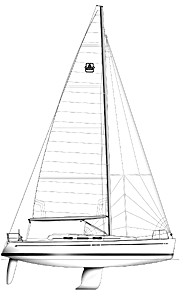Dufour 40
Performance cruiserr
I have a soft spot for the Dufour line. I once sailed a Chicago-Mackinac Race in a Dufour Arpege 30. We were the slowest rated boat in the fleet and the light winds that year did not favor our underpowered little boat. Insects were faster than we were, plaguing us the entire way. Still it was a very interesting little boat well suited to offshore sailing, a style we seldom see today in small boats.
This new Dufour 40 is a design by Umberto Felci with the interior and deck design by Patrick Roseo. Construction is French. The brochure is marvelous and contains some interesting technical contradictions, but heck, it's only advertising. As I see it, the new 40 is an attempt at a comfortable and quick dual-purpose boat, something we are seeing frequently these days.
The hull shows short ends and lots of beam aft. The L/B is 3.17 and that indicates a beamy boat. Carrying that beam aft adds stability and sailing length but more importantly, I think, makes for more interior volume aft. You see this feature regularly today. The D/L is 165. There is nothing unusual about this hull shape that I can see from the profile and plan view. The canoe body maximum depth looks pretty far aft. There are two keels available: one with a 5-foot, 3-inch draft and another with a 6-foot, 11-inch draft.
You can choose from three interior layouts. The center portion of the interior-the galley, nav area and saloon-remain the same but the end treatments differ. You can get three staterooms and two heads, three staterooms with one head or two staterooms with one head. The three stateroom versions are ideal for chartering or cruising with big families. There is a choice of forward stateroom layouts and I prefer the one with the berth to the side as it affords a much larger fo'c'sle for stowage. You pay for this with a slightly smaller double berth. If you go with the two stateroom layout you get a big lazarette to starboard, a nice shower stall and the large fo'c'sle.
The deck-stepped, fractional rig is supported by swept spreaders. I don't trust brochure "sail area" figures; I trust I, J, E and P dimensions. I have a sail area listed for the 40 as 958 square feet and this works out to a SA/D ratio of 24. This looks like an artificially high number to me so I would conclude that the SA listed includes mainsail roach and perhaps even some genoa LP in addition to the regular J dimension. This is common in brochures but doesn't help us in comparing rig figures. Using the actual I, J, E and P numbers I get a SA/D of 18.32. One of the benefits of the fractional rig is that it gets the mast farther forward than it would be with a masthead rig. This puts the mast or compression post, in this case, where it doesn't interfere as much with the saloon layout.
This is a handsome boat. The flattish sheerline compliments the contours of the cabintrunk. I don't have a deck plan but I would imagine that with that much beam aft the cockpit would be very spacious.
Construction is similar to what we see in many of the French production boats with a single skin laminate below the DWL and a cored laminate above the DWL. The deck is laid up using the Resin Transfer Molding (like Scrimp) method for significant weight savings. The shoal draft keel is cast iron.

Comments